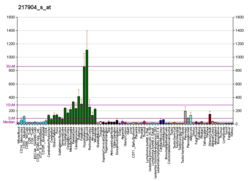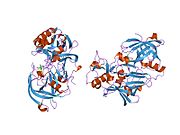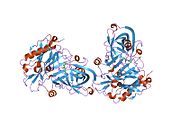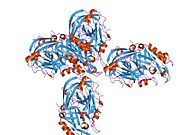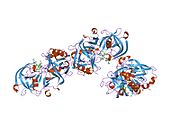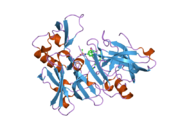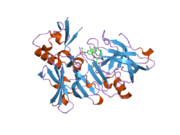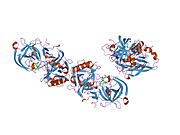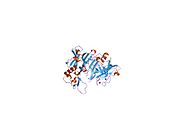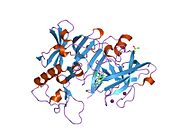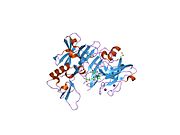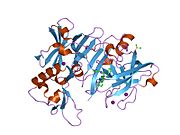Beta-secretase 1
Beta-secretase 1,also known asbeta-site amyloid precursor protein cleaving enzyme 1,beta-site APP cleaving enzyme 1(BACE1),membrane-associated aspartic protease 2,memapsin-2,aspartyl protease 2,andASP2,is anenzymethat in humans is encoded by theBACE1gene.[5]Expression of BACE1 is observed mainly inneuronsandoligodendrocytes.[6]
BACE1 is anaspartic acid proteaseimportant in the formation ofmyelin sheathsin peripheral nerve cells: in mice the expression of BACE1 is high in the postnatal stages, whenmyelinationoccurs.[7]Thetransmembrane proteincontains two active siteaspartateresidues in itsextracellularprotein domainand may function as adimer,its cytoplasmic tail is required for the correct maturation and an efficient intracellular trafficking, but does not affect the activity. It is produced as apro-enzyme,the endoproteolitc removal occurs after BACE leavesendoplasmic reticulum,in theGolgi apparatus.In addition thepro-peptidereceives additional sugars to increase the molecular mass.[8]and the tail became apalmitoylated.[citation needed]
The BACE1 expression is influenced by the inflammatory state: duringADthecytokinesreduce thePPAR1an inhibitor of BACE1 mRNA.[citation needed]
Role in Alzheimer's disease
[edit]
BACE1 is the major beta secretase for the generation ofamyloid-βpeptidesin the neurons.[9]
Generation of the 40 or 42amino acid-longamyloid-βpeptidesthat aggregate in thebrainof Alzheimer's patients requires two sequential cleavages of theamyloid precursor protein(APP). Extracellular cleavage of APP by BACE1 creates a soluble extracellular fragment and a cell membrane-bound fragment referred to as C99. Cleavage of C99 within its transmembrane domain byγ-secretasereleases the intracellular domain of APP and produces amyloid-β. Sincegamma-secretasecleaves APP closer to thecell membranethan BACE1 does, it removes a fragment of the amyloid-β peptide. Initial cleavage of APP by α-secretase rather than BACE1 prevents eventual generation of amyloid-β, formingP3,this demonstrates that BACE1 andAlpha secretasecompete for the APP processing.
Unlike APP and thepresenilinproteins important in γ-secretase, no knownmutationsin thegeneencoding BACE1 cause early-onset,familial Alzheimer's disease,which is a rare form of the disorder. However, levels of this enzyme have been shown to be elevated in the far more common late-onset sporadic Alzheimer's.BACE2is a closehomologof BACE1 with no reported APP cleavagein vivo.
The physiological purpose of BACE's cleavage of APP and other transmembrane proteins is unknown: some studies observed that BACE1 is involved inmyelination(it is co-express withneuregulin 1type III). In a manner analogous to APP processing, theVGSCsubunit beta is a substrate for BACE1.[10]
However a single residue mutation in APP reduces the ability of BACE1 to cleave it to produce amyloid-beta and reduces the risk of Alzheimer's disease and other cognitive declines.[11][12]
BACE inhibitors
[edit]Drugs to block this enzyme (BACE inhibitors) in theory would prevent the buildup of beta-amyloid and (per theAmyloid hypothesis) may help slow or stop Alzheimer's disease.[13]
For Alzheimer's disease
[edit]Several companies are in the early stages of development and testing of this potential class of treatment.[14][15]In March 2008 phase I results were reported for CoMentis Inc's candidate CTS-21166.[16]
In April 2012Merck & Co.,Inc reported phase I results for its candidateverubecestat(MK-8931).[17]Merck began a Phase II/III trial of MK-8931 in December, 2012 estimated to be completed in July 2019.[18]In February 2017, Merck halted its late-stage trial of verubecestat for mild to moderate Alzheimer's disease after it was reported as having "virtually no chance" of working according to an independent panel of experts. This came just three months after Eli Lilly & Co. announced its own setback withsolanezumab.
In September 2014AstraZenecaandEli Lilly and Companyannounced an agreement to codeveloplanabecestat(AZD3293).[19]A pivotal Phase II/III clinical trial of lanabecestat started in late 2014,[20]but was halted in 2018 before its planned conclusion due to poor results.[21]
Another BACE1 inhibitor that has reached phase II trials is the Eli Lilly's inhibitor LY2886721. The data on phase I trial were first presented at the Alzheimer's Association International conference in 2012. Daily dosing during 2 weeks, reduced BACE1 activity by 50–75% and CSF Aβ42 by 72% (Willis et al., 2012; Bowman Rogers and Strobel, 2013). Recently, Lilly reported that the phase II trial of LY2886721 was terminated due to liver abnormalities that were found in 4 out of 45 patients (Rogers, 2013). This toxicity, however, does not have to be related to the working mechanism of the inhibitor, but can represent off-target effects as the livers of BACE1 knockout mice are normal.
Potential side effects
[edit]Tests in mice have indicated that BACE proteases, specifically BACE1, are necessary for the proper function ofmuscle spindles.[22]These results raise the possibility that BACE inhibiting drugs currently being investigated for the treatment of Alzheimer's may have significant side effects related to impaired motor coordination,[23]though BACE1knockoutmice are healthy.[24]
Relationship to plasmepsin
[edit]BACE1 is distantly related to the pathogenic aspartic-acid proteaseplasmepsin,which is a potential target for future anti-malarial drugs.[25]
References
[edit]- ^abcGRCh38: Ensembl release 89: ENSG00000186318–Ensembl,May 2017
- ^abcGRCm38: Ensembl release 89: ENSMUSG00000032086–Ensembl,May 2017
- ^"Human PubMed Reference:".National Center for Biotechnology Information, U.S. National Library of Medicine.
- ^"Mouse PubMed Reference:".National Center for Biotechnology Information, U.S. National Library of Medicine.
- ^Vassar R, Bennett BD, Babu-Khan S, Kahn S, Mendiaz EA, Denis P, et al. (October 1999)."Beta-secretase cleavage of Alzheimer's amyloid precursor protein by the transmembrane aspartic protease BACE".Science.286(5440): 735–741.doi:10.1126/science.286.5440.735.PMID10531052.S2CID42481897.Archivedfrom the original on 2019-04-09.Retrieved2019-07-01.
- ^Rajani RM, Ellingford R, Hellmuth M, Harris SS, Taso OS, Graykowski D, et al. (July 2024)."Selective suppression of oligodendrocyte-derived amyloid beta rescues neuronal dysfunction in Alzheimer's disease".PLOS Biology.22(7): e3002727.doi:10.1371/journal.pbio.3002727.PMC11265669.PMID39042667.
- ^Willem M, Garratt AN, Novak B, Citron M, Kaufmann S, Rittger A, et al. (October 2006). "Control of peripheral nerve myelination by the beta-secretase BACE1".Science.314(5799): 664–666.Bibcode:2006Sci...314..664W.doi:10.1126/science.1132341.PMID16990514.S2CID8432207.
- Lay summary in:Phillips ML (September 21, 2006)."Alzheimer's enzyme important for myelin".The Scientist.
- ^Capell A, Steiner H, Willem M, Kaiser H, Meyer C, Walter J, et al. (October 2000)."Maturation and pro-peptide cleavage of beta-secretase".The Journal of Biological Chemistry.275(40): 30849–30854.doi:10.1074/jbc.M003202200.PMID10801872.
- ^Cai H, Wang Y, McCarthy D, Wen H, Borchelt DR, Price DL, et al. (March 2001). "BACE1 is the major beta-secretase for generation of Abeta peptides by neurons".Nature Neuroscience.4(3): 233–234.doi:10.1038/85064.PMID11224536.S2CID11973104.
- ^Kim DY, Carey BW, Wang H, Ingano LA, Binshtok AM, Wertz MH, et al. (July 2007)."BACE1 regulates voltage-gated sodium channels and neuronal activity".Nature Cell Biology.9(7): 755–764.doi:10.1038/ncb1602.PMC2747787.PMID17576410.
- ^"Alzheimer's-fighting gene may inspire treatments".July 2012.Archivedfrom the original on 2012-05-15.Retrieved2012-07-16.
- ^Jonsson T, Atwal JK, Steinberg S, Snaedal J, Jonsson PV, Bjornsson S, et al. (August 2012). "A mutation in APP protects against Alzheimer's disease and age-related cognitive decline".Nature.488(7409): 96–99.Bibcode:2012Natur.488...96J.doi:10.1038/nature11283.PMID22801501.S2CID4333449.
- ^Pradeepkiran JA, Reddy AP, Yin X, Manczak M, Reddy PH (January 2020)."Protective effects of BACE1 inhibitory ligand molecules against amyloid beta-induced synaptic and mitochondrial toxicities in Alzheimer's disease".Human Molecular Genetics.29(1): 49–69.doi:10.1093/hmg/ddz227.PMC7001603.PMID31595293.
- ^Walker LC, Rosen RF (July 2006). "Alzheimer therapeutics-what after the cholinesterase inhibitors?".Age and Ageing.35(4): 332–335.doi:10.1093/ageing/afl009.PMID16644763.
- ^Baxter EW, Conway KA, Kennis L, Bischoff F, Mercken MH, Winter HL, et al. (September 2007). "2-Amino-3,4-dihydroquinazolines as inhibitors of BACE-1 (beta-site APP cleaving enzyme): Use of structure based design to convert a micromolar hit into a nanomolar lead".Journal of Medicinal Chemistry.50(18): 4261–4264.doi:10.1021/jm0705408.PMID17685503.
- ^"CoMentis BACE Inhibitor Debuts".April 2008.Archivedfrom the original on 2013-09-26.Retrieved2012-07-16.
- ^"Merck Presents Results of a Phase I Clinical Trial Evaluating Investigational BACE inhibitor MK-8931 at American Academy of Neurology".April 2012. Archived fromthe originalon 2012-07-28.
- ^"Merck Initiates Phase II/III Study of Investigational BACE Inhibitor, MK-8931, for Treatment of Alzheimer's Disease".December 2012. Archived fromthe originalon 2017-02-27.Retrieved2012-12-13.
- ^"AstraZeneca and Lilly announce alliance to develop and commercialise BACE inhibitor AZD3293 for Alzheimer's disease".16 Sep 2014.Archivedfrom the original on 23 September 2015.Retrieved8 Oct2014.
- ^"AstraZeneca and Lilly move Alzheimer's drug into big trial".Reuters.December 2014.Archivedfrom the original on 2015-10-25.Retrieved2017-06-30.
- ^"Update on Phase III Clinical Trials of lanabecestat".12 June 2018.Archivedfrom the original on 5 June 2022.Retrieved20 June2018.
- ^Cheret C, Willem M, Fricker FR, Wende H, Wulf-Goldenberg A, Tahirovic S, et al. (July 2013)."Bace1 and Neuregulin-1 cooperate to control formation and maintenance of muscle spindles".The EMBO Journal.32(14): 2015–2028.doi:10.1038/emboj.2013.146.PMC3715864.PMID23792428.
- ^Pettersson AF, Olsson E, Wahlund LO (2005). "Motor function in subjects with mild cognitive impairment and early Alzheimer's disease".Dementia and Geriatric Cognitive Disorders.19(5–6): 299–304.doi:10.1159/000084555.PMID15785030.S2CID36382718.
- ^Roberds SL, Anderson J, Basi G, Bienkowski MJ, Branstetter DG, Chen KS, et al. (June 2001)."BACE knockout mice are healthy despite lacking the primary beta-secretase activity in brain: implications for Alzheimer's disease therapeutics".Human Molecular Genetics.10(12): 1317–1324.doi:10.1093/hmg/10.12.1317.PMID11406613.
- ^Russo I, Babbitt S, Muralidharan V, Butler T, Oksman A, Goldberg DE (Feb 2010)."Plasmepsin V licenses Plasmodium proteins for export into the host erythrocyte".Nature.463(7281): 632–6.Bibcode:2010Natur.463..632R.doi:10.1038/nature08726.PMC2826791.PMID20130644.
- Lay summary in:"Scientists find ideal target for malaria therapy".ScienceDaily(Press release). February 4, 2010.
Further reading
[edit]- Hong L, He X, Huang X, Chang W, Tang J (2005). "Structural features of human memapsin 2 (beta-secretase) and their biological and pathological implications".Acta Biochimica et Biophysica Sinica.36(12): 787–792.doi:10.1093/abbs/36.12.787.PMID15592644.
- Johnston JA, Liu WW, Todd SA, Coulson DT, Murphy S, Irvine GB, et al. (2006). "Expression and activity of beta-site amyloid precursor protein cleaving enzyme in Alzheimer's disease".Biochemical Society Transactions.33(Pt 5): 1096–100.doi:10.1042/BST20051096.PMID16246054.S2CID44248549.
- Dominguez DI, Hartmann D, De Strooper B (2006). "BACE1 and presenilin: two unusual aspartyl proteases involved in Alzheimer's disease".Neuro-Degenerative Diseases.1(4–5): 168–74.doi:10.1159/000080982.PMID16908986.S2CID26746944.
- Zacchetti D, Chieregatti E, Bettegazzi B, Mihailovich M, Sousa VL, Grohovaz F, et al. (2007). "BACE1 expression and activity: relevance in Alzheimer's disease".Neuro-Degenerative Diseases.4(2–3): 117–26.doi:10.1159/000101836.PMID17596706.S2CID32898359.
External links
[edit]- TheMEROPSonline database for peptidases and their inhibitors:A01.004
- beta-Secretase: Molecule of the MonthArchived2012-11-21 at theWayback Machine,by David Goodsell, RCSB Protein Data Bank
- HumanBACE1genome location andBACE1gene details page in theUCSC Genome Browser.
- Overview of all the structural information available in thePDBforUniProt:P56817(Human Beta-secretase 1) at thePDBe-KB.






